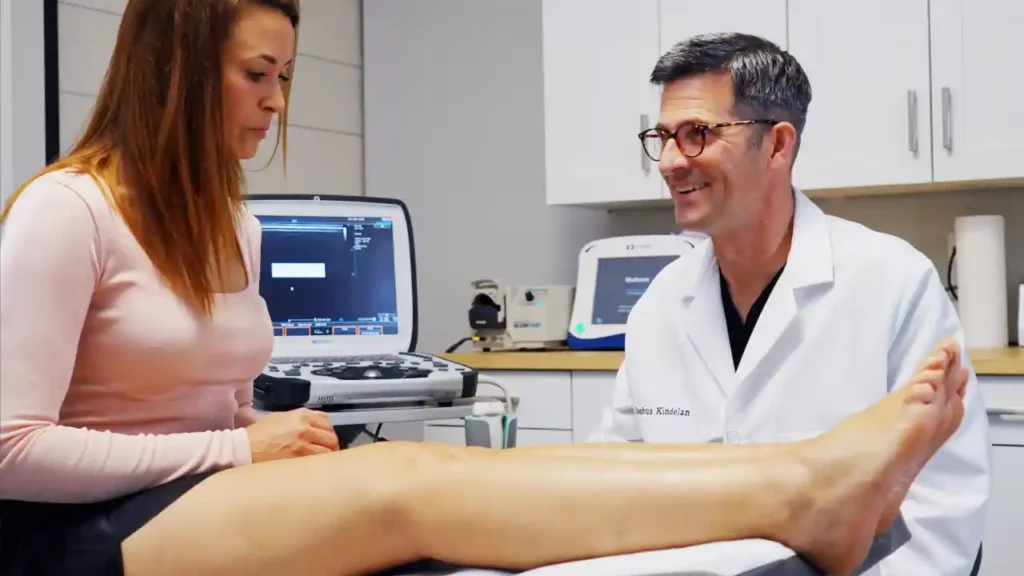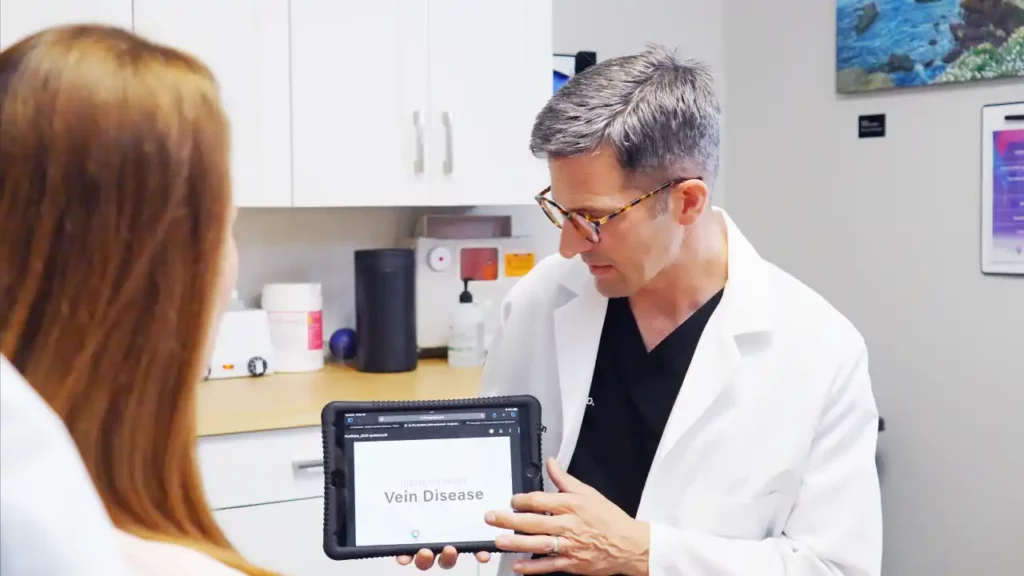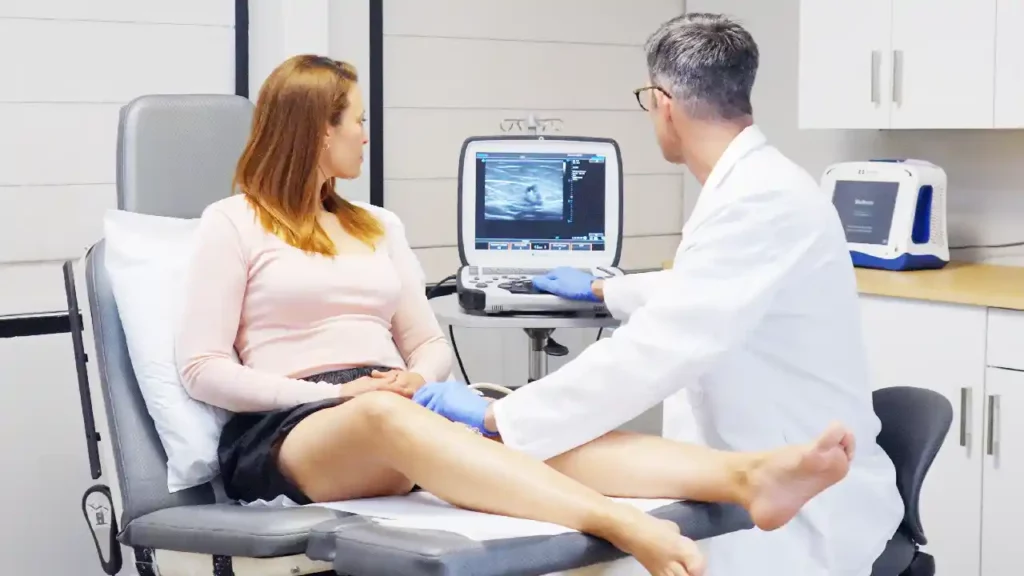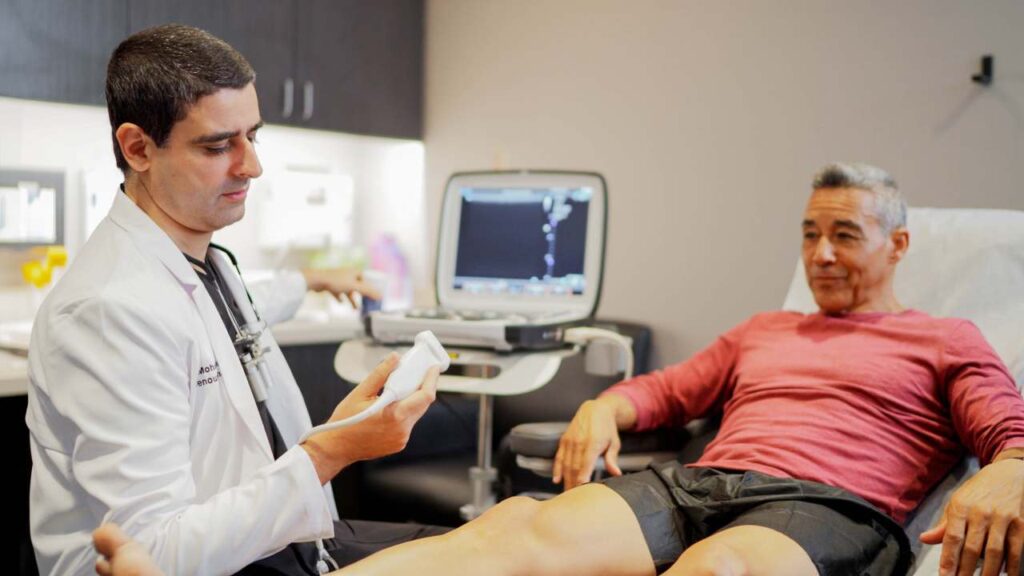Dr. Kindelan Explains What Causes Spider Veins
If you’ve noticed small, red or purple veins branching out across your legs, you’re probably wondering what causes spider veins and if they’re something to worry about. Spider veins are tiny, visible blood vessels that appear just under the skin’s surface, often in the legs or face. While they may seem harmless, they’re often caused by chronic venous insufficiency, a medical condition in which blood pools in the veins due to faulty valves.
Dr. Joshua Kindelan at Vein Treatment CA in San Diego is a board-certified vein doctor with a surgical background who specializes in diagnosing and treating spider veins. If you’re in or around San Diego and struggling with spider veins on legs, he’s here to help. In this article, we explain what causes spider veins and the best spider veins treatment.
What Causes Spider Veins?
Before we dive into the causes, let’s clarify what spider veins are. Spider veins are small, damaged veins that appear as red, purple, or blue lines. They’re usually painless but can be accompanied by symptoms like heaviness, itching, or leg fatigue. Now, here’s the part most people don’t know: spider veins are often caused by chronic venous insufficiency (CVI).
Chronic venous insufficiency is a serious medical condition where the valves in your leg veins don’t function properly. Instead of pushing blood up toward the heart, the valves let blood flow backward and pool in the veins. This added pressure can cause nearby surface veins to burst or stretch, leading to visible spider veins.
So, what causes chronic venous insufficiency in the first place? Several risk factors contribute to weakened or damaged valves in your veins:
- Genetics or family history of vein disease
- Pregnancy or hormonal fluctuations (especially in women)
- Sitting or standing for long hours
- Obesity or excess weight
- Aging and loss of vein elasticity
- Lack of regular exercise
- History of blood clots or vein injuries
These factors can either directly weaken your vein valves or increase the pressure in your leg veins, accelerating vein damage. Over time, this leads to spider veins—and sometimes, varicose veins, which are larger, bulging veins caused by the same underlying issue.
What Causes Spider Veins?
Before we dive into the causes, let’s clarify what spider veins are. Spider veins are small, damaged veins that appear as red, purple, or blue lines. They’re usually painless but can be accompanied by symptoms like heaviness, itching, or leg fatigue. Now, here’s the part most people don’t know: spider veins are often caused by chronic venous insufficiency (CVI).
Chronic venous insufficiency is a serious medical condition where the valves in your leg veins don’t function properly. Instead of pushing blood up toward the heart, the valves let blood flow backward and pool in the veins. This added pressure can cause nearby surface veins to burst or stretch, leading to visible spider veins.
So, what causes chronic venous insufficiency in the first place? Several risk factors contribute to weakened or damaged valves in your veins:
- Genetics or family history of vein disease
- Pregnancy or hormonal fluctuations (especially in women)
- Sitting or standing for long hours
- Obesity or excess weight
- Aging and loss of vein elasticity
- Lack of regular exercise
- History of blood clots or vein injuries
These factors can either directly weaken your vein valves or increase the pressure in your leg veins, accelerating vein damage. Over time, this leads to spider veins—and sometimes, varicose veins, which are larger, bulging veins caused by the same underlying issue.
How To Get Rid Of Spider Veins Naturally?
You might be hoping there’s a natural remedy for spider veins, but here’s the truth: there’s no natural method that can eliminate spider veins once they form. The only way to fully treat them is through minimally invasive spider vein treatment performed by Dr. Kindelan.
That said, there are lifestyle changes that can prevent spider veins from worsening or even lower your risk of developing new ones:
- Wearing compression stockings daily
- Elevating your legs after long periods of sitting or standing
- Taking frequent walking breaks during the day
- Maintaining a healthy weight
- Avoiding high heels and tight clothing
- Eating a high-fiber, low-sodium diet
- Staying hydrated and exercising regularly
While these tips won’t reverse existing spider veins, they can help improve circulation and reduce the pressure that leads to further vein damage. If your legs feel heavy or you’re concerned about vein symptoms, it’s time to see a vein specialist.
What Is The Best Spider Veins Treatment?
Here’s the thing: there’s no one-size-fits-all “best” spider vein treatment. Every patient’s veins are different, which is why Dr. Kindelan starts by using duplex ultrasound to examine the underlying veins and identify any signs of venous insufficiency.
Once he has a clear diagnosis, he curates a personalized treatment plan. If your spider veins are purely cosmetic, he may recommend sclerotherapy alone. But if you also have varicose veins or signs of venous insufficiency, you may need a combination of treatments.
Let’s walk through the most effective vein treatment options:
- Sclerotherapy: This is the gold standard for spider veins treatment. A solution is injected directly into the vein, causing it to collapse and fade over time. It’s quick, requires no downtime, and works especially well on spider veins on legs.
- Endovenous Laser Ablation (EVLA): If your spider veins stem from deeper venous issues, EVLA treats the root cause. A laser fiber is inserted into the faulty vein to seal it shut. It’s performed under local anesthesia and is effective for venous insufficiency treatment.
- Radiofrequency Ablation (RFA): Like EVLA, RFA uses heat to close damaged veins. Instead of a laser, it uses radiofrequency energy. It’s a safe and comfortable option, often used for varicose veins and underlying valve failure.
- VenaSeal: A medical adhesive is used to close off the diseased vein. VenaSeal doesn’t require heat or tumescent anesthesia, which makes recovery even easier for many patients.
- ClariVein: This technique uses a rotating catheter and a medicated solution to close the vein from the inside. ClariVein is minimally invasive and particularly effective for tortuous veins.
- Ambulatory Phlebectomy: This minor surgical procedure removes large surface veins through tiny incisions. Ambulatory phlebectomy is often paired with other treatments to remove visible varicose veins left after treating venous insufficiency.
Why Choose Dr. Kindelan For Spider Veins Treatment?
Dr. Joshua Kindelan is a board-certified vein doctor at Vein Treatment CA in San Diego, located at 5330 Carroll Canyon Rd, Suite 140. He’s not just a vein specialist—he’s also a fellowship-certified expert in minimally invasive vein treatments. He completed his general surgery residency at the Bethesda Naval Hospital and his cardiovascular and thoracic surgery at Northwestern University Medical Center.
Dr. Kindelan is also registered in vascular interpretation, which means he’s qualified to personally evaluate your ultrasound results to diagnose the root cause of your symptoms. Whether you’re dealing with spider veins, varicose veins, or simply legs that feel heavy, you’re in the hands of a skilled and compassionate vein physician.
You’ll also be pleased to know that most of our vein treatments are covered by medical insurance. While spider veins are often labeled as cosmetic, their underlying cause—venous insufficiency—is a medical condition. So, if you’re diagnosed with CVI, your spider vein treatment (including sclerotherapy) may also be covered.
Vein Treatment CA has multiple locations throughout California, including San Diego, Irvine, Newport Beach, San Jose, and Palo Alto. Contact us to schedule a consultation and get expert care from Dr. Kindelan and the team at Vein Treatment CA in San Diego today.






